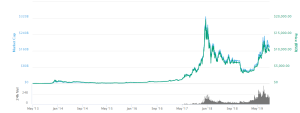Understanding Bitcoin Mining: A Comprehensive Guide
Dive deep into the world of Bitcoin mining! Uncover the mysteries behind this crucial process, learn how it works, and understand its impact on the Bitcoin ecosystem. Become a Bitcoin mining expert!
Bitcoin, the pioneering cryptocurrency, operates on a decentralized network secured by a process known as mining. Understanding Bitcoin mining is crucial to grasping the fundamental mechanics of this digital currency. This process involves solving complex mathematical problems to validate transactions and add new blocks to the blockchain. Let’s delve into the intricacies of this fascinating and often misunderstood aspect of the Bitcoin ecosystem.
What is Bitcoin Mining?
At its core, Bitcoin mining is a computationally intensive process that verifies and adds transactions to the Bitcoin blockchain. Miners use specialized hardware to solve complex cryptographic puzzles. The first miner to solve the puzzle adds the next block of transactions to the blockchain and receives a reward, typically in newly minted Bitcoins. This reward incentivizes miners to participate in securing the network and maintaining its integrity.
The Role of Miners in Securing the Network
The decentralized nature of Bitcoin relies heavily on the collective effort of miners. By constantly verifying transactions and adding blocks to the blockchain, miners contribute to the overall security and stability of the network. This makes it incredibly difficult for malicious actors to alter past transactions or create fraudulent Bitcoins. The more miners participating, the more secure the network becomes.
How Bitcoin Mining Works: A Step-by-Step Guide
The process of Bitcoin mining involves several key steps. Firstly, miners receive a block of pending transactions from the Bitcoin network. They then begin the computationally intensive process of solving a cryptographic hash puzzle. This puzzle requires finding a number that, when combined with the block’s data, produces a hash that meets specific criteria. The first miner to find this solution broadcasts the solution to the network, and their block is added to the blockchain.
Upon successful addition of a block, the miner receives a reward in Bitcoin. This reward is halved approximately every four years, a process known as halving, which controls the rate of new Bitcoin creation. Additionally, miners also earn transaction fees included in the block they successfully mine. These fees are paid by users to prioritize their transactions and ensure faster confirmation times.
The Cryptographic Puzzle
The cryptographic puzzle at the heart of Bitcoin mining involves finding a number that, when combined with the block’s data and hashed using a SHA-256 algorithm, produces a result that meets certain criteria; This criteria usually involves the hash starting with a specific number of leading zeros. The more leading zeros required, the harder the puzzle becomes, and the more computational power is needed to solve it.
The Blockchain: A Permanent Record
Once a miner solves the puzzle and adds a block to the blockchain, this transaction becomes part of the permanent, immutable record of all Bitcoin transactions. This immutability is a key feature of Bitcoin, ensuring its security and preventing double-spending. The blockchain’s distributed nature means it is replicated across numerous nodes, making it highly resistant to tampering or manipulation.
Hardware and Software Requirements for Bitcoin Mining
Mining Bitcoin requires specialized hardware and software. The days of mining Bitcoin profitably with a standard computer are long gone. Modern Bitcoin mining relies on Application-Specific Integrated Circuits (ASICs), purpose-built chips designed for the sole purpose of solving cryptographic hash puzzles efficiently.
ASIC Miners: The Workhorses of Bitcoin Mining
ASIC miners are highly specialized devices with significantly more computational power than general-purpose CPUs or GPUs. They are designed to maximize the efficiency of solving the cryptographic puzzles required for Bitcoin mining. The higher the hash rate (measured in hashes per second), the greater the chance of successfully mining a block and earning a reward.
Mining Software: Essential Tools for Miners
Mining software is necessary to connect your ASIC miner to the Bitcoin network, manage the mining process, and receive your rewards. Popular mining software options offer features like remote monitoring, automatic configuration, and pool integration. Choosing the right software is crucial for maximizing your mining efficiency and profitability.
Bitcoin Mining Pools: Collaborating for Success
Given the difficulty of mining Bitcoin solo, most miners join mining pools. A mining pool is a group of miners who combine their computing power to increase their chances of solving the cryptographic puzzle and earning rewards. When a block is successfully mined by the pool, the reward is distributed among the contributing miners based on their contribution to the pool’s total hash rate.
Advantages of Joining a Mining Pool
- Increased chances of earning rewards: Pooling resources significantly increases the likelihood of finding a block.
- More consistent income: Miners receive regular payouts based on their contribution, rather than relying on infrequent, large rewards.
- Reduced risk: The risk of investing substantial resources without earning any rewards is minimized.
The Economics of Bitcoin Mining: Profitability and Costs
The profitability of Bitcoin mining is heavily influenced by several factors. The most significant is the Bitcoin price. A higher Bitcoin price translates to higher rewards for miners. Conversely, a lower price can make mining unprofitable. Other factors include the cost of electricity, the hash rate of your mining equipment, and the difficulty of mining Bitcoin.
Electricity Costs: A Major Expense
Bitcoin mining is energy-intensive. Electricity consumption is a major operating expense for miners. Areas with low electricity costs are more attractive for setting up large-scale mining operations. The cost of electricity directly impacts the profitability of mining operations.
Mining Difficulty: A Dynamic Challenge
The Bitcoin network adjusts its difficulty every 2016 blocks to maintain a consistent block generation time of approximately 10 minutes. As more miners join the network, the difficulty increases, making it harder to mine a block. This adjustment ensures the stability and security of the Bitcoin network.
Hardware Costs and Depreciation: Initial Investment and Ongoing Expenses
The initial investment in ASIC miners can be substantial. Furthermore, ASIC miners have a limited lifespan and depreciate over time. Factors like maintenance, repairs, and eventual replacement should be factored into the overall cost analysis.
Environmental Concerns and the Future of Bitcoin Mining
The energy consumption associated with Bitcoin mining has raised environmental concerns. The high energy demands of ASIC miners have led to discussions about the sustainability of the Bitcoin network. Efforts are being made to explore more energy-efficient mining techniques and transition to renewable energy sources to mitigate the environmental impact.
Sustainable Mining Practices: A Growing Focus
The Bitcoin mining industry is increasingly recognizing the need for sustainable practices. Initiatives are underway to utilize renewable energy sources such as solar and hydro power to power mining operations. These efforts aim to reduce the carbon footprint of Bitcoin mining and promote a more environmentally friendly approach.
Is Bitcoin Mining Right for You?
Before venturing into Bitcoin mining, carefully consider the factors discussed above. Bitcoin mining requires significant upfront investment in specialized hardware, ongoing operational costs, and technical expertise. The profitability of Bitcoin mining is dynamic and influenced by several factors, including the price of Bitcoin, electricity costs, and the mining difficulty. Thorough research and careful planning are crucial to assess the feasibility and potential profitability of Bitcoin mining for your specific circumstances.
- Assess your financial resources: Bitcoin mining requires a substantial upfront investment.
- Evaluate electricity costs in your area: High electricity costs can significantly impact profitability.
- Understand the technical aspects: Bitcoin mining involves specialized hardware and software.
- Research mining pools: Joining a pool increases your chances of earning rewards.
Successfully navigating the world of Bitcoin mining demands a blend of technical proficiency, financial acumen, and a keen awareness of market fluctuations. Understanding the intricacies of the underlying technology, alongside the economic factors influencing profitability, is essential for informed decision-making. The potential rewards are substantial, but the risks are equally significant; meticulous planning is paramount before embarking on this endeavor. Ultimately, the decision to engage in Bitcoin mining rests upon a careful weighing of potential gains against the inherent risks and complexities involved. The competitive landscape necessitates continuous adaptation and optimization to maintain profitability within this dynamic industry. The future of Bitcoin mining will undoubtedly be shaped by technological advancements, regulatory changes, and the evolving environmental considerations. Continuous learning and adaptation are key to long-term success in this field.







